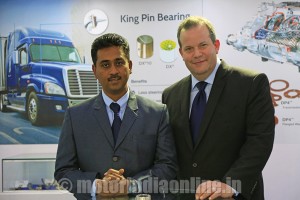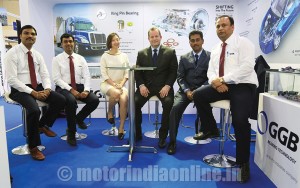GGB Bearing Technology, a global leader in high performance bearings, is on a strong run in the Indian market. The company’s Indian operations have continued to grow in line with the growing market acceptance of its world-class technology products. This signals a major shift from cost to quality focus in the country. GGB expects to achieve double-digit growth in the current year as well, as it continues to focus heavily on the Asian market as part of its global growth strategy.

Despite the Indian automotive market going through a rough patch for the last two years, GGB has managed to buck the trend, having registered healthy growth in 2014. Says Mr. Mathias Senghaas, General Manager, GGB Asia: “We have done very well in the last 12 months in India with our team doing a great job to grow our sales. We have been successful in the market, which is a good sign despite a not very supportive economy in recent times. We expect our growth to continue and we plan to keep adding resources in engineering and sales to serve our customers better and expand our presence geographically.”
One main reason for GGB’s success has been its focus on certain applications by working closely with its customers, while another is the clear trend that the Indian market is moving towards higher quality products. “Many of our customers did go for other low-cost bearing options, but after a relatively short period of time, they came back to us because of our quality, reliability and ability to deliver on our promises. We provide good technical and engineering service, even in the design stage, which our customers appreciate a lot”, he adds.
GGB’s Indian operations grew significantly in 2014, driven by its focus on suspension and steering segments for trucks, shock absorbers and a few other automotive applications. Apart from unmatched technology and superior quality, GGB’s diversity is another of its competitive advantages, helping the company balance fluctuations in different segments in the market.
Cost vs. Quality
It is a no secret that the Indian market has historically been cost-driven. However, GGB’s growth is an interesting case indicating that India is slowly but surely bridging the gap with developed markets by moving away from focusing primarily on cost to opting for better quality products.
“We realize when we talk to customers in India that focus on quality and safety is much more prominent than in the past. So I personally believe that things are going in the right direction in the Indian market. We hope the infrastructure development happens as planned, and as we have seen in markets like the US when the first customer moves (from cost to quality), everyone moves. We expect something similar to happen in India”, shares Mr. Senghaas.
Being a global power, GGB is actively working on making customers in the Indian market understand the long-term benefits of superior quality where the total cost of ownership during the life cycle of the product is much lower than cheaper alternatives. “We speak about cost of ownership that goes beyond the depreciating price and have demonstrated to some customers how the cost of ownership helps them save money even in the medium-term. We clearly see this mindset changing not just in India but all over Asia”, he says.
GGB works closely with manufacturers of components and systems such as axles, suspensions, steerings, etc. Its current customer base in the Indian market is skewed 70:30 in favor of global brands, though the home-grown ones are catching up fast.
A ripple effect of GGB’s growth in the country could see Tier-I suppliers upgrade to better technology which is followed by the vehicle OEMs stepping up quality levels, thereby delivering a much better product to the end-user. The reverse is also true, as Mr. Senghaas explains: “The expectation of the end customer on quality and reliability is rising year by year, which is pushing the vehicle OEMs to improve, and this in turn pushes the Tier-I supplier to upgrade in order to stay in the game. Also, the Indian component manufacturing units will become much more export oriented, which means they will compete with global players for which they really need to upgrade.”

Adding his views on the topic, Mr. Mahesh Thangamani, India Sales Manager, says: “The Indian Government provides incentives such as duty-cuts based on the size of vehicles. Ideally, this should be based on aspects like safety, fuel efficiency, emission and performance rather than the size as it would surely drive the growth of advanced technology in the market.”
Within the automotive space, GGB’s main share of business comes from the passenger car segment, mainly due to the large volumes in the segment. In commercial vehicles, its main application is in truck suspensions wherein it boasts of a breakthrough solution, something which none of its competitors has at present. GGB also caters to other applications like transmissions, pedals, clutches and brake systems, and sees opportunities to penetrate into segments like king-pins and steerings in the near future.
Aftermarket
GGB serves both the OE and aftermarket segments of the global automotive industry. The company made its first participation in the recently-held ACMA Automechanika show in New Delhi to get a feel of the segment in India. Though not its focus area, GGB runs campaigns in the aftermarket to educate people on its trademarks and ensure no customer gets deceived by counterfeits, which not only raises a safety concern for the end-user but could also hurt GGB’s brand reputation.
“Our products for the aftermarket and OEM come from the same production line, but since our bearings normally last longer than the actual application, there is no big aftermarket for us in the first place. We run regular campaigns to educate customers on our trademarks as part our efforts to make people aware of our quality and reliability”, states Mr. Senghaas.
As for future plans, GGB expects to continue registering double-digit annual growth and is quite optimistic about the future of the Indian market. The company will keep the automotive sector as its focal point as it gears up to make further inroads in the market. “We see positive signs in the market and hope this is not a short-term effect. Our major focus would remain on the automotive segment, which includes heavy trucks and passenger cars. We will continue to transfer more knowledge to our Asian and Indian teams to be able to educate our customers better on the advantages of using our products.”